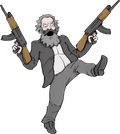I've just finished my mech eng diploma and to keep up solidworks and drawing practice thought I'd dust off my silly "Bullpuppest Bullpup" idea. It's not really for ever actually making, but just exploring weird ideas based on some workshop experience and watching a lot of Forgotten Weapons and other gun disassembly. It's loosely based on the TBK-022PM, the F-2000, and some of those weapons that turn the bullet from the magazine to chambering. Awful complicated mechanics all around.
Anyway, I was going to make it in 5.56x45 NATO as I'm in a NATO country and assumed that would be the easiest ammunition to get (as well as pre-cut M16 or AR-15 barrels or whatever, and I didn't want to fiddle with ballistics really). However, I've had a heck of a time finding the technical drawings for the round (STANAG 4178)/chamber/magazine well dimensions to design around. (Yes, apparently it's not actually an accepted standard, but it would be nice to have something to work around)
I've also noticed that a lot of the supplied technical drawings are very old scans of very old drawings, with almost unreadable dimensions (and are often incomplete). Every AK-47M drawing that I seem to find, something that I feel must have an abundance of drawings, seems to be a tiny grainy picture maybe with cursive Cyrillic written all over it or something. M16A1 etc seems to also. Also, a lot of drawings have one or two dimensions missing that would be trivial to measure and include in a 3D model.
So I thought it would be a good practice project for me to take some of these old drawings and after much examination, interpretation, and discussion (and potentially measuring actual objects), reproduce the drawings in a very clear and readable format. The actual making of 3D models (especially if they are traditionally machined parts) does not take very long once dimensioned, and I can upload them here or where-ever. Solidworks is actually pretty intrusive with what details about your computer it includes in drawings/parts, so probably PDFs until I can work out how to scrub everything with the Admin tool SW has (if possible, hexeditors maybe).
I'm also pretty open to just changing the ammunition/magazine standard etc. to whatever, even a made up one. Can't do any physical testing, but would work fine for a "fantasy" gun for like... idk, an imaginary modern soviet Industrial Concern. The US Army seems to want its funny high powered 277 Fury with the stainless case base (is that really the best way of doing things).
It's also fine to roleplay as an engineer or end user with complaints and stuff around the design, but don't get too heated about it. This is mostly just a project to whet teeth on and get brain juices flowing.
What do I want from gun nerds? Interpretation of technical drawings Measurements for real parts (e.g. I could not find the STANAG magazine feed lip dimensions or how far the catch is from the lips etc, some parts could be reverse engineered based on the size of the round). Access to lots of parts is impractical, so we'd basically guess and decide what the tolerances were based on other parts. Design suggestions/comments (mostly for fun, this is a very silly design)
What does everyone get? Up to date, modern technical drawings with cut lists, welds, BOM, 3D modelled parts, tolerances (where possible) without having to squint at tiny pictures of scans and cursive cyrillic. I'm happy to do extra models/drawings for whatever "base gun" we're building off; models/drawings are pretty easy once details are finalised.
Current Decisions: Ammo/magazine standard. Probably based on ease of getting drawings, dimensioning, or models, but if there's an interesting set of old drawings we can use that as a standard we can go with that. Can hypothetically invent dimensions (and primers are standardised and interference fit, so that part is already "designed").
Odd features I'm including because I'm a weirdo (the absurd design is partly the point):
- Pulls ammunition from traditional AR sickle mag that runs almost parallel to the main length, turns the bullet 90°-ish, and shoves it into the chamber, thus maybe reducing the distance between the rear of the gun and the chamber.
- Funny membrane that pushes air out of the barrel when cycling
- Different funny membrane that has a filter (for dust) that allows air in but not out, and no water in
- Forward ejector for spent rounds (but like... yet another way of doing it)
- Different bullpup trigger/action
By the end, I hope to have something of an absurd rube goldberg machine wrapped up in a modern (or whatever aesthetic) shell. But that might be a couple of years down the line.
Notes:
- Could crib measurements from video game models for some looser fits maybe.
- I'm not above stealing other people's ideas, patented or not. But this is partly practice for me.

That said, concerning yourself with actual chamber dimensions doesn't really matter until something's being made. I'd just treat the barrel&chamber as a magic cylinder that does what you need it to in the design, as the actual execution of chamber and rifling cutting is:
It's all gonna be done with very specialized tools rather than generic machine shop stuff.
There are some ways around this that the 3d printed firearm community is working on, such as ECM rifling.